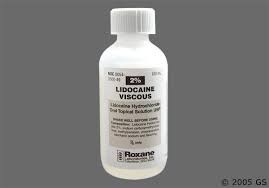WARNING
Lidocaine viscous may cause serious side effects or death in infants or children under 3 years of age if not used as recommended. Do not use lidocaine viscous to treat teething pain. Only use lidocaine viscous in infants or children under 3 years when prescribed by your doctor. Do not use more of it or use it more often than prescribed by your doctor.
Store this medication tightly closed and safely out of reach of children. Discard unused medication out of reach of children and pets.
Why is this medication prescribed?
Lidocaine viscous, a local anesthetic, is used to treat the pain of a sore or irritated mouth and throat often associated with cancer chemotherapy and certain medical procedures. Lidocaine viscous is not normally used for sore throats due to cold, flu, or infections such as strep throat.
How should this medicine be used?
Lidocaine viscous comes as a thick liquid and should be shaken well before using. Lidocaine viscous usually is used as needed but not more frequently than every 3 hours, with a maximum of 8 doses in 24 hours. In children under 3 years of age, do not use more frequently than every 3 hours, with a maximum of 4 doses in 12 hours. Follow the directions on your prescription label carefully, and ask your doctor or pharmacist to explain any part you do not understand. Use lidocaine exactly as directed. Do not use more or less of it or use it more often than prescribed by your doctor.
For a sore or irritated mouth, the dose should be placed in the mouth, swished around until the pain goes away, and spit out.
For a sore throat, the dose should be gargled and then may be swallowed. To avoid or decrease side effects, use the minimum amount of drug needed to relieve your pain.
In infants and children under 3 years of age, use a measuring device to carefully measure the correct dose. Apply the medication to the affected area using a cotton-tipped applicator.
Because lidocaine viscous decreases the feeling in your mouth and/or throat, it may affect your ability to swallow. Avoid eating for at least 1 hour after you have used this drug. You should also avoid chewing gum while using this medication.
Other uses for this medicine
This medication is sometimes prescribed for other uses; ask your doctor or pharmacist for more information.
What special precautions should I follow?
Before using lidocaine viscous,
- Tell your doctor and pharmacist if you are allergic to lidocaine, anesthetics, any other medications, or any of the ingredients in lidocaine viscous. Ask your pharmacist for a list of the ingredients.
- Tell your doctor and pharmacist what other prescription and nonprescription medications, vitamins, nutritional supplements, and herbal products you are taking or plan to take.
- Tell your doctor if you are pregnant, plan to become pregnant, or are breast-feeding. If you become pregnant while using lidocaine, call your doctor.
What should I do if I forget a dose?
Use the missed dose as soon as you remember it. However, if it is almost time for the next dose, skip the missed dose and continue your regular dosing schedule. Do not use a double dose to make up for a missed one.
What side effects can this medication cause?
Lidocaine viscous may cause side effects. If you experience any of the following symptoms or those listed in the IMPORTANT WARNING section, stop using lidocaine viscous and call your doctor immediately or get emergency medical treatment:
- Rash
- Itching
- Hives
- Shallow breathing
- Difficulty breathing or swallowing
- Drowsiness
- Blurred or double vision
- Shakiness
- Irregular heartbeat
- Vomiting
- Seizures
- Ringing in the ears
If you experience a serious side effect, you or your doctor may send a report to the Food and Drug Administration’s (FDA) MedWatch Adverse Event Reporting program online (http://www.fda.gov/Safety/MedWatch) or by phone (1-800-332-1088).
What should I know about storage and disposal of this medication?
Keep this medication in the container it came in, tightly closed, and out of reach of children. Store it at room temperature and away from excess heat and moisture (not in the bathroom).
It is important to keep all medication out of sight and reach of children as many containers (such as weekly pill minders and those for eye drops, creams, patches, and inhalers) are not child-resistant and young children can open them easily. To protect young children from poisoning, always lock safety caps and immediately place the medication in a safe location – one that is up and away and out of their sight and reach. http://www.upandaway.org
Unneeded medications should be disposed of in special ways to ensure that pets, children, and other people cannot consume them. However, you should not flush this medication down the toilet. Instead, the best way to dispose of your medication is through a medicine take-back program. Talk to your pharmacist or contact your local garbage/recycling department to learn about take-back programs in your community. See the FDA’s Safe Disposal of Medicines website (http://goo.gl/c4Rm4p) for more information if you do not have access to a take-back program.
What other information should I know?
Keep all appointments with your doctor.
Do not let anyone else use your medication. Ask your pharmacist any questions you have about refilling your prescription.
It is important for you to keep a written list of all of the prescription and nonprescription (over-the-counter) medicines you are taking, as well as any products such as vitamins, minerals, or other dietary supplements. You should bring this list with you each time you visit a doctor or if you are admitted to a hospital. It is also important information to carry with you in case of emergencies.
Brand names
- Xylocaine® Viscous


